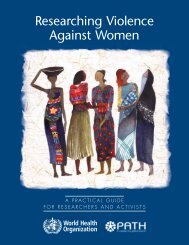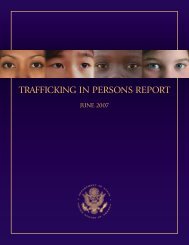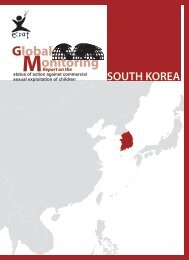Download PDF - Violence Against Children - East Asia and the ...
Download PDF - Violence Against Children - East Asia and the ...
Download PDF - Violence Against Children - East Asia and the ...
Create successful ePaper yourself
Turn your PDF publications into a flip-book with our unique Google optimized e-Paper software.
executive summary<br />
responsibility of states to protect children.<br />
Collaboration across all sectors is vital to<br />
promote change <strong>and</strong> ensure <strong>the</strong> realisation of<br />
children’s rights.<br />
Lessons learned from civil society practice<br />
in promoting child protection need to be<br />
shared. There is no magic formula – no single<br />
intervention that works in all environments –<br />
but st<strong>and</strong>ing out as giving value <strong>and</strong> hope to<br />
children are programs whose designs<br />
effectively apply common principles of <strong>the</strong><br />
CRC; <strong>the</strong> commitment of individuals <strong>and</strong><br />
agencies to work in difficult, uncertain areas;<br />
approaches gaining <strong>the</strong> support of o<strong>the</strong>rs to<br />
underst<strong>and</strong> <strong>and</strong> act on problems limiting <strong>the</strong><br />
lives of children; <strong>and</strong> practice that results in<br />
changed attitude, behaviour, <strong>and</strong> resources.<br />
Impact can be measured in many ways, but<br />
increasing hope of children <strong>and</strong> communities<br />
is a particularly valuable indicator, as it is an<br />
investment in both today <strong>and</strong> tomorrow.<br />
Experiences detailed in this report show<br />
where NGOs including World Vision have<br />
been able to extend <strong>the</strong> practical role of<br />
governance in key areas of protection,<br />
prevention <strong>and</strong> development. They engage on<br />
areas of priority reflected in <strong>the</strong> aspirations of<br />
children <strong>and</strong> noted as concerns by country<br />
mechanisms monitoring <strong>the</strong> implementation<br />
of <strong>the</strong> CRC. Program models that promote<br />
children’s participation in development also<br />
serve to streng<strong>the</strong>n protection of children.<br />
Direct service makes a difference to<br />
beneficiaries, but its impact can be fur<strong>the</strong>red<br />
when linked to advocacy on policy. Research<br />
demonstrating <strong>the</strong> links between <strong>the</strong> “micro”<br />
<strong>and</strong> “macro” aspects of child protection can<br />
promote change at both levels. Greater<br />
attention is needed to getting <strong>the</strong> message,<br />
whe<strong>the</strong>r of good practice or emerging<br />
problems, into <strong>the</strong> public arena. One aspect<br />
of globalisation is <strong>the</strong> increased availability,<br />
speed <strong>and</strong> influence of information. Initiatives<br />
that work well to address child protection in<br />
<strong>the</strong> field can, if communicated in a timely <strong>and</strong><br />
accessible way, influence program designs in<br />
o<strong>the</strong>r countries <strong>and</strong> regions.<br />
Over <strong>the</strong> past 20 years, NGOs have<br />
documented <strong>and</strong> published on child abuse<br />
<strong>and</strong> neglect, pushed for legal change <strong>and</strong><br />
aroused public opinion. Never before have<br />
states agreed to accept so many restrictions<br />
on <strong>the</strong>ir domestic behaviour or to submit to<br />
so much international scrutiny. 4 Change is<br />
often difficult, but it is possible.<br />
Indeed, as this report demonstrates, <strong>the</strong><br />
practical interventions needed to protect<br />
children <strong>and</strong> reduce <strong>the</strong> threats to <strong>the</strong>ir<br />
safety <strong>and</strong> well-being are clearly do-able. So<br />
what is holding us back?<br />
At grassroots level, <strong>the</strong> ideas <strong>and</strong> energy to<br />
bring about change often already exist – <strong>the</strong>y<br />
need to be resourced <strong>and</strong> mobilised. It is<br />
crucial that at higher levels, decisions<br />
(including that of inaction) do not have <strong>the</strong><br />
effect of holding back important changes at<br />
<strong>the</strong> grassroots.<br />
This report’s focus is from a civil society<br />
perspective, but clearly draws attention to<br />
<strong>the</strong> need for ongoing government <strong>and</strong> donor<br />
commitment. Local <strong>and</strong> national government<br />
agencies <strong>and</strong> officials clearly have a primary<br />
role in protecting children, <strong>and</strong> NGO activity<br />
should never be seen as a replacement for<br />
government obligations.<br />
At <strong>the</strong> same time, “from whom much is<br />
given, much shall be required”. Of most<br />
concern has been <strong>the</strong> lack of initiatives by all<br />
donors/lenders to assist governments with<br />
budget support <strong>and</strong> capacity-building help for<br />
children at risk. The failure of major<br />
development institutions to recognise <strong>and</strong><br />
address <strong>the</strong> problem of children at risk<br />
reflects <strong>the</strong> very marginalisation of this<br />
problem. International institutions such as <strong>the</strong><br />
World Bank, which seek to pressure states to<br />
streng<strong>the</strong>n governance <strong>and</strong> improve <strong>the</strong> rule<br />
of law, have been insufficiently concerned to<br />
ensure that children benefit from <strong>the</strong>ir<br />
efforts.<br />
This report shows examples of what can be<br />
4 See, for example, "The world is watching: A survey of human rights law", The Economist, 5 December 1998<br />
6

















